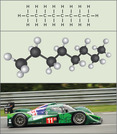
9 Results


Biology is designed for multi-semester biology courses for science majors. It is grounded on an evolutionary basis and includes exciting features that highlight careers in the biological sciences and everyday applications of the concepts at hand. To meet the needs of today’s instructors and students, some content has been strategically condensed while maintaining the overall scope and coverage of traditional texts for this course. Instructors can customize the book, adapting it to the approach that works best in their classroom. Biology also includes an innovative art program that incorporates critical thinking and clicker questions to help students understand—and apply—key concepts.
- Subject:
- Biology
- Life Science
- Material Type:
- Full Course
- Provider:
- Rice University
- Provider Set:
- OpenStax College
- Date Added:
- 08/22/2012

- Subject:
- Biology
- Life Science
- Material Type:
- Unit of Study
- Provider:
- Rice University
- Provider Set:
- OpenStax College

- Subject:
- Applied Science
- Biology
- Life Science
- Material Type:
- Module
- Date Added:
- 07/10/2017

By the end of this section, you will be able to:Define “energy”Explain the difference between kinetic and potential energyDiscuss the concepts of free energy and activation energyDescribe endergonic and exergonic reactions
- Subject:
- Applied Science
- Biology
- Life Science
- Material Type:
- Module
- Date Added:
- 07/10/2017

By the end of this section, you will be able to:Define “energy”Explain the difference between kinetic and potential energyDiscuss the concepts of free energy and activation energyDescribe endergonic and exergonic reactions
- Subject:
- Applied Science
- Biology
- Life Science
- Material Type:
- Module
- Author:
- Tina B. Jones
- Date Added:
- 08/15/2019

This course aims to connect the principles, concepts, and laws/postulates of classical and statistical thermodynamics to applications that require quantitative knowledge of thermodynamic properties from a macroscopic to a molecular level. It covers their basic postulates of classical thermodynamics and their application to transient open and closed systems, criteria of stability and equilibria, as well as constitutive property models of pure materials and mixtures emphasizing molecular-level effects using the formalism of statistical mechanics. Phase and chemical equilibria of multicomponent systems are covered. Applications are emphasized through extensive problem work relating to practical cases.
- Subject:
- Applied Science
- Chemistry
- Engineering
- Physical Science
- Physics
- Material Type:
- Full Course
- Provider:
- MIT
- Provider Set:
- MIT OpenCourseWare
- Author:
- Tester, Jefferson
- Trout, Bernhardt
- Date Added:
- 09/01/2003

This resource is a video abstract of a research paper created by Research Square on behalf of its authors. It provides a synopsis that's easy to understand, and can be used to introduce the topics it covers to students, researchers, and the general public. The video's transcript is also provided in full, with a portion provided below for preview:
"As materials scientists know well, one reliable way to make strong metals even stronger is to shrink their already-tiny crystalline grains. It’s a time-tested technique that’s made today’s cars, planes, and armor safer than ever. But at the nanoscale, grains are notoriously fickle. Their strong tendency to grow makes it nearly impossible for researchers to chase higher levels of strength. But that could soon change. A new computer model developed by researchers from MIT shows how nano-sized grains might be stabilized in metal alloys. Their findings could provide the blueprint for constructing harder and stronger metals. Alloying one metal with another is one technique that has helped researchers push grain sizes to smaller and smaller scales—thanks to a process known as segregation. As the grains in a metal shrink, the addition of a small amount of an alloying metal segregate, or adhere, to the boundaries between different grains..."
The rest of the transcript, along with a link to the research itself, is available on the resource itself.
- Subject:
- Applied Science
- Engineering
- Material Type:
- Diagram/Illustration
- Reading
- Provider:
- Research Square
- Provider Set:
- Video Bytes
- Date Added:
- 09/23/2019

This course provides an introduction to the chemistry of biological, inorganic, and organic molecules. The emphasis is on basic principles of atomic and molecular electronic structure, thermodynamics, acid-base and redox equilibria, chemical kinetics, and catalysis.
In an effort to illuminate connections between chemistry and biology, a list of the biology-, medicine-, and MIT research-related examples used in 5.111 is provided in Biology-Related Examples.
Acknowledgements
Development and implementation of the biology-related materials in this course were funded through an HHMI Professors grant to Prof. Catherine L. Drennan. Videos and captioning were made possible and supported by the MIT Class of 2009.
- Subject:
- Chemistry
- Physical Science
- Material Type:
- Full Course
- Provider:
- MIT
- Provider Set:
- MIT OpenCourseWare
- Author:
- Drennan, Catherine
- Taylor, Elizabeth
- Date Added:
- 09/01/2008